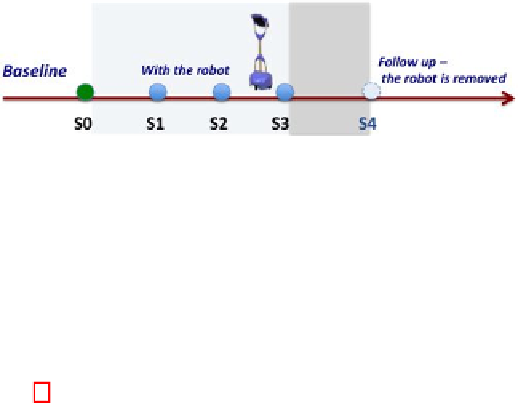Information Technology Reference
In-Depth Information
Fig. 4.
The Long Term Evaluation timeline
3.2
Long Term Evaluation
One of the original features of the E
X
CITE project consists of realizing long-term
experiments involving older people hosting the robot in their living environment both
to communicate with others and to receive assistance services.
Method.
Figure 4 gives a general idea of the designed method to evaluate features over
time. The evaluation entails a period of
N
months (with
3
12
) during which
the end user will have the robot at home and the clients can visit him/her through it.
Assessment happens at milestones
S
i
. Specifically, after an initial assessment (S0 in
figure) at the beginning of the experimentation (
baseline
), the variables of interest are
measured at regular intervals (S1-3) to observe changes over time. At the last month
the G
IRAFF
will be removed from the end user apartment and the same variables will
be assessed again after 2 months from this removal (S4). The general idea is to use a
repeated measures method to see changes over time during the long term usage of the
robot.
≤
N
≤
Participants and Procedure.
Three different cases have been identified to cover differ-
ent situations in which the robot can be deployed. Specifically, for the client typology
of users we considered (a) a
formal caregiver
belonging to an Health care organiza-
tion; (b) a
family member (caregiver)
;(c)
other relatives or friends
who may visit the
elderly person through the robot. The type of material used in the long term evalua-
tion for both the client and the end user depends upon the type of interaction for which
the telepresence is used. For this reason, for each of the three mentioned situations we
had developed (or selected) a set of questionnaires (almost all validated in the three
languages of the involved countries) aimed at monitoring specific variables and to be
administrated at specific time both to end users and to clients.
Material.
For each of the described case we prepared the material to assess the variables
under study at the specified intervals. Table 1 lists in detail the different variables and
the related instruments to be used to measure the variables over time.
Client Side.
Specifically on the client side, during the initial step (S0), we use: (a) an
informed
consent form
describing the aim and procedure of the study; (b) the
socio
demographic data
form to gather some relevant information on the user; (c) we de-
veloped on purpose a questionnaire aimed at assessing the client expectation on the
G
IRAFF
's ability to ease the support (
Support Expectation
). It is worth highlighting that

